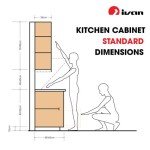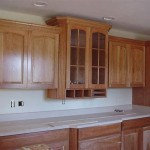Cleaning Inside of Old Kitchen Cabinets: A Comprehensive Guide
Maintaining the cleanliness of your kitchen cabinets is crucial for both aesthetics and hygiene. Old kitchen cabinets, in particular, require special attention due to potential dirt accumulation and aging-related issues. This article provides a comprehensive guide to effectively clean the inside of old kitchen cabinets, restoring their functionality and appearance.
1. Empty and Remove Shelves
Begin by emptying the contents of the cabinets completely. Remove all shelves and drawers for thorough cleaning. This step is essential for accessing the entire interior surface and ensuring a deep clean.
2. Wipe Down Surfaces
Use a damp cloth or sponge to wipe down the inside walls, doors, and shelves of the cabinets. Start with a mild cleaning solution, such as a mixture of warm water and a few drops of dish soap. Use gentle strokes to avoid damaging the surface.
3. Tackle Grime and Grease
For stubborn grime or grease, a stronger cleaning solution is necessary. Mix equal parts white vinegar and water in a spray bottle and apply it to the affected areas. Allow it to sit for a few minutes before wiping with a damp cloth. Alternatively, you can use a commercial degreaser specifically designed for kitchen cabinets.
4. Clean Drawers
Drawers require special attention due to the potential for food residue and spills. Remove all utensils and other contents, then wipe them down with a cleaning solution. If the drawers have removable drawer slides, take them out and clean them separately.
5. Inspect and Repair
While cleaning, carefully inspect the interior of the cabinets for any signs of damage, such as loose hinges, broken shelves, or peeling paint. Address these issues promptly to prevent further deterioration and ensure the continued functionality of the cabinets.
6. Disinfect
To eliminate bacteria and germs, disinfect the inside surfaces of the cabinets with a household disinfectant. Follow the manufacturer's instructions for dilution and application. Allow the disinfectant to air dry completely before storing food.
7. Deodorize
If the cabinets have an unpleasant odor, place a small bowl of baking soda in the corners or on the bottom of the cabinets. Baking soda naturally absorbs odors and helps to keep the cabinets fresh. Alternatively, you can use a commercial cabinet deodorizer.
8. Protect
Once the cabinets are thoroughly cleaned, consider applying a protective coating to prevent future stains and grease buildup. There are various products available, such as cabinet liners or clear sealers, that can help to preserve the cabinets.
Conclusion
By following these steps, you can effectively clean the inside of old kitchen cabinets, restoring their functionality and appearance. Regular cleaning and maintenance will extend the lifespan of your cabinets and keep your kitchen hygienic and organized. Remember to check for damages, disinfect surfaces, and deodorize to ensure a thorough and complete clean.

How To Clean Kitchen Cabinets Everyday Skate

How To Clean Kitchen Cabinets 9 Basics Bob Vila

How To Clean Kitchen Cabinets Everyday Skate

How Can I Get Old Kitchen Cabinets To Stop Smelling Clean

Contents Corner The Scoop On Cabinet Cleaning Inside Out Restoration Remediation

How To Clean Kitchen Cabinets So The Entire Room Shines

Kitchen Cabinets 9 Easy Repairs Diy Family Handyman

Kitchen Deep Cleaning Checklist Tips Polished Habitat

How To Paint Kitchen Cabinets Budget Friendly Makeover

21 Diy Affordable Ways To Redo Kitchen Cabinets Extra Space Storage
Related Posts








